
Not all clients will have an accurate idea of how a logo design is created, some may have a good idea, some may think they know but don’t and some just admit to not knowing the first thing.
In the past, I have had a number of occasions where I assumed aspects of my logo design process were obvious. Fail. Confused and unhappy clients can be avoided if you lay it all out on the line before commencing work.
Writing detailed logo design process posts is a big help here, but it’s not the only thing you could be doing.
Confusion is easy to make, easy to remedy
The confusion is easy to understand when you consider that most logo designers have their own unique way of working. How many ideas will you first show, how do you go about generating ideas, how do you submit ideas to your clients, how much you do envolve the client with your idea process? There are many more aspects to our job that can be hard for a client to understand.
Just securing that next logo project, getting the brief and getting stuck in is not enough. Do you want a sound footing from which the client can understand and fully appreciate how and what you are doing? Then the more you can communicate your methods and what the client can expect the better. No matter how much they are investing in you, we all need to be reassured that what we are spending out hard earned money on is in good hands.
Silence is not generally conducive to a happy and assured client.
I can’t tell you exactly how to achieve this, as I mentioned a few paragraphs back, we all have different ways of working. Consider this. Even if your client understand and appreciates design, they are still unlikely to know and understand your own unique way of working. This much you can pretty much be sure of.
Try not to assume that they will see what’s coming, or when to expect something or know how you plan to present your ideas. Do you have any unique skills, do you work significantly differently to other designers you know? If so, you need to try and communicate your intended process once you ready to get started.
How I roll
I have a rather organic way of working, no two projects start the same. It all comes down to the brief and the nature of the logo design. My process is very free flowing and can appear to be quite scatty if you look at my process out of context. Even though it’s all perfectly natural and methodical to me, to others it can seem quite disjointed.
In the past I would fall back into ‘assuming’ a clients understands my way of working, and I would forget to fully explain myself at various stages. Even though I have outlined my basic approach at the proposal stage, this is still not enough to satisfy any doubts or concerns or expectations a client might have.
With each new client, I need to explain my methods as they present themselves. My explanations are tailored to the client and to the job in question, so there is always a personal feel to my communications, even if the email takes hours to write.
I don’t present 3-5 complete concepts, then expect the client to choose one. Then go through a round of tweaks and revisions. This method has always seemed sterile, forced and just odd to me. That’s just my own personal view.
Trust your brief, Trust your instincts
I trust my gut. I trust my instincts. Having a thorough brief is essential to starting on the right track, an incomplete or scatty brief and you have a uphill challenge. An example of how an incomplete brief ‘my fault’ derailed a project can be seen in the logo process post for Apple & Eve.
Experience has shown me that I tend to ‘imagine’ a solid idea right from the outset, (even if I have a incomplete brief, go figure) and this is where I focus my time. I have to feel totally sure about it, I have to be able to sell this initial idea with all my heart.
Now, how I go about showing this initial idea can vary, it can be a loose pencil sketch or it can be a neat Illustrator vector file, it all depends on the project. But this is where it has and could go a little topsy turvy. If I don’t put into context this initial idea/concept, the client could be assuming this is actually the ‘finished’ idea, especially if you are showing vector artwork.
It just seems to be that if you show someone a vector file, with fonts and colours, they will naturally see it as a finished idea, unless ofcourse you say otherwise.

An example of this is a recent logo design for MyModernMet. My initial idea/concept is on the left, the final artwork is on the right.
I don’t always start sketching, often I can start visualising direct in Illustrator. Other times I will have pages and pages of pencil doodles, it just depends on the project. So this is a good example of how this initial gut idea/sketch/concept can evolve. Quite a difference between the two, but the left hand image was created to just ‘portray’ my general idea and direction, without jumping fully in.
The initial idea was VERY loose, but in my head it was fully formed. I have to keep reminding myself that clients don’t actually have access to my thoughts.
It was chosen as a framework from which to explore and expand upon, even though in it’s present form, it was less than appropriate for the clients requirements.Without explaining your methods and your reasoning, showing the left hand idea without any explanation is likely to ‘freak’ someone out. It might seem obvious, but one can forget that you are the only one that truly understands your design process.
I have started using this screenshot as an example of my process with new clients, it demonstrates quite effectibly how a seemingly raw idea can spring to life, given the trust and confidence of the client.
I do stress to each client that during the early stages, what they are seeing are basically the raw visions in my head. I ask them to imagine this image being scribbled in pencil on a napkin. Anything I show at this stage is an ‘idea/sketch/concept’ and needs to be viewed as such. That the client is seeing the raw interpretations of the brief knocking around my mind, rather than a polished final piece of artwork.
I keep reminding the client of this until I am in a position to start showing them more final artwork.
It’s down to you
This was just to give you an idea of how I tackle this particular issue. Providing graphic examples of your process, a before and after can greatly help a client get on board with your logo design process. How you go about it is ultimately down to you, but it’s something I still have to keep reminding myself to do. Just because it’s second nature to me, for others it’s likely to be a totally foreign experience, and baby steps are needed.
